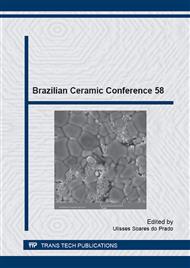p.18
p.24
p.30
p.36
p.40
p.46
p.51
p.56
p.60
Study of a Typical Soil Used for Concrete Bricks in Miracema, State of Rio de Janeiro, Brazil
Abstract:
The use of natural resources for sustainable development is becoming a relevant issue in modern societies. In particular, building materials composed of local soil or available residues are considered sustainable solutions for housing construction in relatively small urban areas. In the present work a preliminary study was conducted on a typical soil in the municipal area of Miracema, state of Rio de Janeiro, Brazil. The study comprised the characterization of the particle size distribution and particle density of the soil. In addition, the application of the soil by combining with Portland cement was investigated to produce concrete blocks specified as soil-cement bricks by the Brazilian norm. The results indicated that a trace of 14 parts of soil, 6 parts of local gravel and 4 parts of cement/water produced concrete blocks that comply with the compression strength specified by the norm.
Info:
Periodical:
Pages:
40-45
Citation:
Online since:
June 2015
Price:
Сopyright:
© 2015 Trans Tech Publications Ltd. All Rights Reserved
Share:
Citation:


